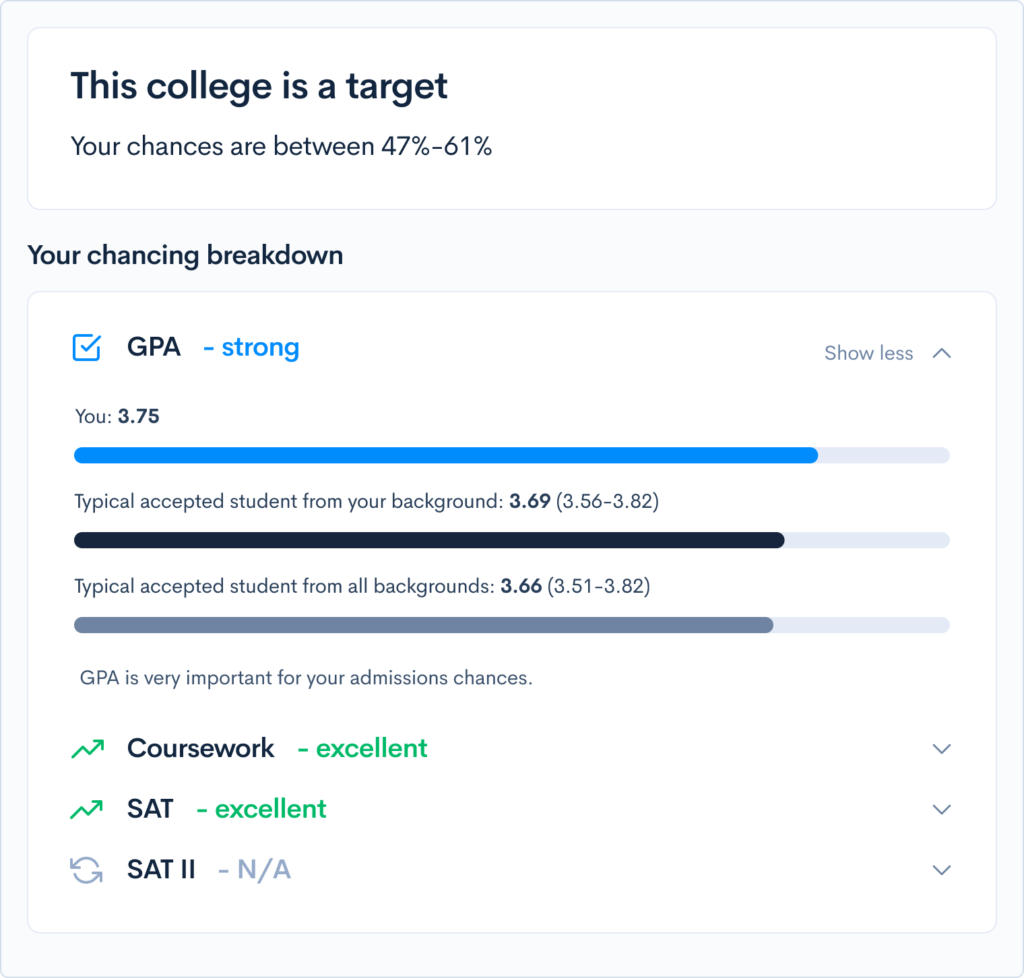15 Hardest SAT Writing & Language Questions
The SAT Writing & Language section is 35 minutes long and features 44 questions. You’ll be asked to read passages and correct any weaknesses in the writing. Questions cover aspects like tone, word choice, syntax, punctuation, and more. If you’d like more practice with the trickier writing concepts, this is the post for you! In this post, we will cover the hardest SAT Writing and Language questions we’ve come across out of many of the College Board’s officially released tests. Of course, “hard” is subjective, so some of these may actually seem easy to you, and that’s fine! Our goal is simply to help you identify your grammatical strengths and weaknesses. Currently, most colleges accept both the ACT or SAT and take it heavily into consideration as a predictor of college success (outside of non-COVID years). In fact, selective schools use grades and test scores as a filter, so if your academics aren’t up to par, you may get automatically rejected. If you want to know how your SAT score impacts your chances of acceptance to your dream schools, you might like our free Chancing Engine. It will help you predict your odds, let you know how you stack up against other applicants, and suggest aspects of your profile to improve. Unlike other solely stats-based chancing calculators, ours considers much of your entire profile, including your stats, extracurriculars, and demographic background. Sign up for your free CollegeVine account today to gain access to our Chancing Engine and jumpstart your college journey! Before diving into the questions, we want you to understand the terms that the SAT uses to categorize the topics as defined by the College Board. We’ve also included the number of questions that fall under each category, so if you’re self-studying, you can prioritize the types of questions that appear more often or that you struggle with more. These questions may ask you to improve the way passages develop information and ideas. This may involve choosing answers to sharpen an argumentative claim or add relevant supporting detail. These questions may ask you to improve word choice based on the text surrounding them. You will aim to make a passage more precise or concise or to improve syntax, style, or tone. These questions ask about a passage’s organization and its impact. You will be asked which words or structural changes improve the author’s point and help their sentences and paragraphs work together. These cover the building blocks of writing: sentence structure, usage, and punctuation. You’ll be asked to change words, clauses, sentences, and punctuation. Some topics covered include verb tense, parallel construction, subject-verb agreement, and comma usage. This isn’t a question type that is officially listed, but about 2% of questions will involve a data-based graphic like a chart, table, or graph. You may be asked to edit the graph to make it more accurate or select a data-based sentence to add to support an argument. From Practice Test 3: Answer: C Category: Command of Evidence Explanation: While somewhat related to the message of the text, this piece of information is best left out here, as it would hinder its natural flow. Without it, the passage flows smoothly from the first mention of circadian rhythms to a more detailed explanation of them. A is incorrect because although this data might be useful for the reader to know, the placement is awkward and interruptive. If the author were to choose to include this information, it would likely be best for them to do so later in the passage, where the effects of sleep deprivation are discussed. B is incorrect because A) the placement still disrupts the flow, and B) it fits better with the latter part of the paragraph, where the effects of sleep deprivation are discussed. D is incorrect because while its comment on the nature of the statistic is true, it is irrelevant to the objective of the passage. From Practice Test 3: This question refers to the following text: For as long as Harvey Houses served rail travelers through the mid-twentieth century, working there was a steady and lucrative position for women. Living independently and demonstrating an intense work ethic; the Harvey Girls became known as a transformative force in the American [22] West. Advancing the roles of women in the restaurant industry and the American workforce as a whole, the Harvey Girls raised the standards for restaurants and blazed a trail in the fast-changing landscape of the western territories. For context, the passage concerns a significant change in the food industry. Railway food was originally of poor quality and provided with poor service. Additionally, most waitstaff were men. Businessman Fred Harvey introduced high-quality dining for the first time and intentionally hired a well-mannered, articulate, all-woman staff. It was the U.S.’s first restaurant chain and, as the latter paragraphs of the passage explain, it became immediately and massively popular, empowering women in the workforce and altering the U.S. restaurant economy. Answer: A Category: Command of Evidence Explanation: A is the correct answer because it recognizes the fact that this information specifically evidences the transformative nature of the Harvey Girls’ influence. B is incorrect because the information does not actually serve as a transitional point, as the target sentence is not followed by a discussion of these cultural developments. C is incorrect because A) this answer does not specify precisely where this passage should be moved to or why, and B) the earlier parts of the passage mainly focused on the then-current effects of the Harvey Girls, not later cultural developments. D is incorrect because the passage mainly serves to illustrate the Harvey Girls’ transformative effect (as partially evidenced by the passage title, “Transforming the American West Through Food and Hospitality”) This objective is supported by this evidence of its artistic and intellectual impacts. [amp-cta id="9459"] From Practice Test 5: Answer: C Category: Command of Evidence Explanation: Choice C is the best answer for two reasons. For starters, the year 1954 disrupts the chronology of previous examples (1974, 2004). Secondly, the example concerns television news, which is out of place in a passage aptly titled “Investigative Journalism: An Evolving American Tradition.” A is incorrect because this clarification is unnecessary in a passage that is not actually mainly focused on political corruption. Additionally, it is already directly stated in the paragraph that journalism has served “to keep those in power accountable.” B is incorrect because the sentence is out of place in the paragraph and the passage does not necessitate a “counterpoint” as this is an informative, not argumentative, piece. Additionally, this evidence, if included, would support, not challenge, the author’s previous evidence and claims that informational media helps hold the powerful accountable. D is incorrect because while it correctly states that the sentence should not be added, their reasoning is incorrect. This example of journalists reporting a story to expose a powerful person is consistent with the passage’s definition of investigative journalism. From Practice Test 5: Answer: D Category: Command of Evidence Explanation: Choice D is the best answer because sentence 2 mentions the high price of the playwright’s tickets, which logically follows sentence 5’s description of how the price of tickets was determined. Sentence 2’s claim that the price reflected the real cost of the performance also logically precedes sentence 6, which discusses the non-altruistic nature of these donations. Choices A, B, and C are incorrect because sentence 2 does not naturally follow sentences 1, 3, or 4, respectively. Since sentences 3, 4, and 5 present a logical sequence of activities that establish the ticket price, sentence 2’s reflection on the overall price of the tickets would be out of place. Therefore, sentence 2 must come after the completion of this sequence; it can’t come before the sequence, as noted in choice A, or interrupt it, as noted in choices B and C. From Practice Test 1: This question refers to the following sentence: “Also, because it is more concentrated, Greek yogurt contains slightly more protein per serving, thereby helping people stay [10] satiated for longer periods of time. Answer: A Category: Words in Context Explanation: A is correct because “satiated” is the word that most accurately communicates that Greek yogurt wards off hunger specifically for long periods of time. B is one of those questions that students may pick due to overthinking, but it is incorrect because although “fulfilled” may seem like a tempting answer to students who understand that “fulfillment” indicates some degree of met satisfaction (often in spirituality or career), the word is virtually never used in reference to hunger. C and D are incorrect because neither could specifically refer to somebody who has eaten and is now full. You should not be afraid to choose “NO CHANGE” when the original answer is the most fitting. From Practice Test 3: We’re going to include the first paragraph of this passage to give you a sense of this passage’s tone, but if you’d like to read the whole passage, you may do so here. This question refers to the word “sinister’, as bolded below: “Just as travelers taking road trips today may need to take a break for food at a rest area along the highway, settlers traversing the American West by train in the mid-1800s often found [12] themselves in need of refreshment. However, food available on rail lines was generally of terrible quality. [13] Despite having worked for railroad companies, Fred Harvey, an English-born [14] entrepreneur. He decided to open his own restaurant business to serve rail customers. Beginning in the 1870s, he opened dozens of restaurants in rail stations and dining cars. These Harvey Houses, which constituted the first restaurant chain in the United States, [15] was unique for its high standards of service and quality. The menu was modeled after those of fine restaurants, so the food was leagues beyond the [16] sinister fare travelers were accustomed to receiving in transit.” Answer: C Category: Words in Context Explanation: C is correct because it maintains earlier claims of restaurant food being of poor quality while still maintaining the formal tone established earlier in the passage. A is incorrect because “sinister” ascribes too much agency and humanity to food. B is incorrect because “surly” inappropriately personifies food. D is incorrect because “icky” is too informal for this passage’s tone. From Practice Test 3. This question refers to the following sentence: “1-MCP lengthens storage life by three to four times when applied to apples. This extended life allows producers to sell their apples in the off-season, months after the apples have been harvested.” Answer: A Category: Words in Context Explanation: A is correct because its first clause explains 1-MCP’s impacts on apples, centering the sentence on 1-MCP and creating a concise, natural progression of information. B is incorrect because it involves an awkwardly-placed subordinate clause and lacks conciseness and flow. C is incorrect because it is awkward and flows poorly, with an ineffective progression of ideas. D is incorrect because it is awkward and flows poorly, with an ineffective progression of ideas. From Practice Test 1: This question refers to the underlined sentence within the following excerpt: [6] Though these conservation methods can be costly and time-consuming, they are well worth the effort. Nutritionists consider Greek yogurt to be a healthy food: it is an excellent source of calcium and protein, serves to be a digestive aid, and it contains few calories in its unsweetened low- and non-fat forms. Greek yogurt is slightly lower in sugar and carbohydrates than conventional yogurt is. The paragraph preceding this one describes the negative environmental impacts of acid whey, which is released as a byproduct of Greek yogurt production, before transitioning into a description of ways that scientists and farmers work to offset these negative effects. Answer: D Category: Expression of Ideas Explanation: Choice D is correct because the paragraph really does list the benefits of consuming Greek yogurt, supporting this initial claim of production-based conservation methods being “well worth the effort.” A is incorrect because the sentence actually does serve as a good transition between the previous paragraph, which details the environmental drawbacks and conservation efforts regarding Greek yogurt production, and the following one, which explains why these costly methods are justified by the benefits of Greek yogurt. B is incorrect because this sentence was created not to support any previous arguments, but to set up a new one. Therefore, B misinterprets the sentence in question. C is incorrect because it misinterprets the sentence in question. From Practice Test 1. The question refers to the following text: The article, published by Forbes magazine, explained that coworking spaces are designated locations that, for a fee, individuals can use to conduct their work. The spaces are usually stocked with standard office equipment, such as photocopiers, printers, and fax machines. In these locations, however, the spaces often include small meeting areas and larger rooms for hosting presentations. [28] The cost of launching a new coworking business in the United States is estimated to be approximately $58,000. What most caught my interest, though, was a quotation from someone who described coworking spaces as “melting pots of creativity.” The article refers to a 2012 survey in which 64 percent of respondents noted that coworking spaces prevented them from completing tasks in a given time. The article goes on to suggest that the most valuable resources provided by coworking spaces are actually the people whom use them. Answer: C Category: Expression of Ideas Explanation: Choice C is the best answer because the sentence distracts from the paragraph’s main focus. The cost of setting up a coworking business is irrelevant to all parts of this paragraph and passage, which serves to illustrate the merits of coworking spaces, not the process of building them. Choice A is incorrect because as previously mentioned, this detail does not support the paragraph’s main topic. Choice B is incorrect because the sentence has nothing to do with the second paragraph’s illustration of the resources provided by these spaces. D is incorrect because this information has not been repeated anywhere else in the passage. From Practice Test 3: The question refers to the underlined portion of this passage’s second paragraph: “Artificial light sources are also costly aside from lowering worker productivity. They typically constitute anywhere from 25 to 50 percent of a building’s energy use. When a plant in Seattle, Washington, was redesigned for more natural light, the company was able to enjoy annual electricity cost reductions of $500,000 8 each year..” For context, the previous paragraph first explained the negative effects of artificial light on worker health before explaining their negative effects on worker productivity. Answer: A Category: Expression of Ideas Explanation: Choice A is the correct answer because it begins by referencing the previous paragraph’s topic before launching into the second paragraph’s topic of cost. Choices B, C, and D are all not the best answers because they are written rather awkwardly in comparison to Choice A. In addition, they all fail to provide a smooth transition, either by not opening with a reference to the previous paragraph or not referencing the second paragraph’s topic. From Practice Test 1: This question refers to this sentence: Nutritionists consider Greek yogurt to be a healthy food: it is an excellent source of calcium and protein, serves [7] to be a digestive aid, and it contains few calories in its unsweetened low- and non-fat forms. Answer: B Category: Standard English Conventions Explanation: Choice B is the best answer because it provides a grammatically standard preposition that connects the verb “serves” and the noun “digestive aid” to accurately depict their relationship. A is incorrect because the infinitive “to be” creates a grammatically incorrect verb construction: “serves to be.” Choices C and D are incorrect because both present options that deviate from standard English usage. Some students may struggle with prepositions in particular, so definitely brush up on their respective usages if that sounds like you! From Practice Test 1: This question refers to the following sentence: The novelty of this comfortable work-from-home life, however, [23] soon got worn off quickly. Answer: D Category: Standard English Conventions Explanation: D is correct because “wore” is the only answer that abides by standard English conventions while also not being repetitive. A, B, and C are all incorrect because “promptly” and “quickly” contain a redundancy. From Practice Test 1: This question refers to the following sentence: “Having become frustrated trying to solve difficult problems, [24] no colleagues were nearby to share ideas.” Answer: D Category: Standard English Conventions Explanation: D is correct because it correctly describes the narrator as having become frustrated and discovering a desire to be surrounded by helpful colleagues. A, B, and C are all incorrect because they incorrectly attribute the action of having become frustrated to colleagues, instead of to the narrator. From Practice Test 7: This question refers to the underlined portion of the following sentence: “In truth, the agency has a widespread positive [2] effect on society by serving as a catalyst for innovation and scientific understanding [3] to create jobs, and showing humanity its place within the universe.” Answer: A Category: Standard English Conventions Explanation: Choice A is correct because the noun “effect” is needed in the sentence to provide a direct object for the verb “has.” The article “a” indicates that a noun will follow. B and D use the incorrect word to refer to the agency’s impact on society. C is incorrect because the word “to” is an inaccurate preposition to use here. Students frequently mix up “affect” and “effect” because they sound the same and have similar definitions. Here’s a quick mnemonic to help you remember: “Affect is the action; effect is the end result.” For example, a person may positively affect their health by sleeping 8 hours a night, while increased energy would be a positive effect of doing so. “Affect” is a verb, while “effect” is a noun. From Practice Test 1: Answer: B Category: Data Interpretation Explanation: Choice B is correct because the graph shows that on March 5, average low temperatures hit their lowest at 12 degrees Fahrenheit. Choice A is incorrect because the phrase “as low as” suggests that the temperature falls no lower than 20 degrees Fahrenheit. However, the chart shows that in January, February, and March, the temperature dips below that point. Choices C and D are incorrect because their information does not match the chart’s. Tackling practice questions can be a great way to up your writing skills for the SAT and help you take note of your weaknesses. We especially recommend honing specific skills, especially the ones you may struggle with more. This could involve studying key grammar rules, reviewing words with multiple meanings, workshopping your own writing, reading informational texts, and even interpreting graphical data. Finally, keep in mind that while taking the test, you’ll likely come across multiple options that seem plausible, so it’s easy to get stuck waffling between a few possibilities. Stay focused on what, specifically, the question is asking and avoid being swayed by answers that look “kind of correct” but which really aren’t the best choice in fulfilling the author’s aim. To learn more about how to do well on the SAT, check out our other posts: What’s Covered:
How do SAT Scores Impact Your College Chances?
SAT Writing & Language Question Topics
Command of Evidence
Words in Context
Expression of Ideas
Standard English Conventions
Data Interpretation
15 Hardest SAT Writing & Language Questions
Question 1
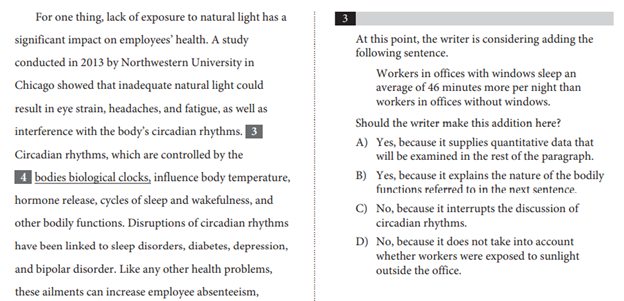
Question 2
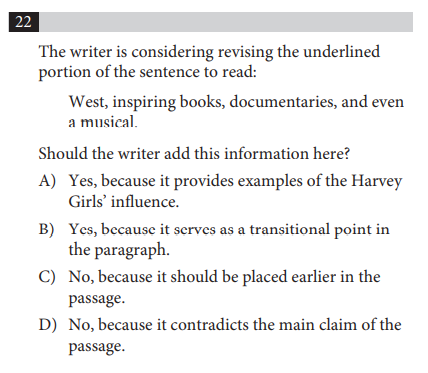

Question 3

Question 4
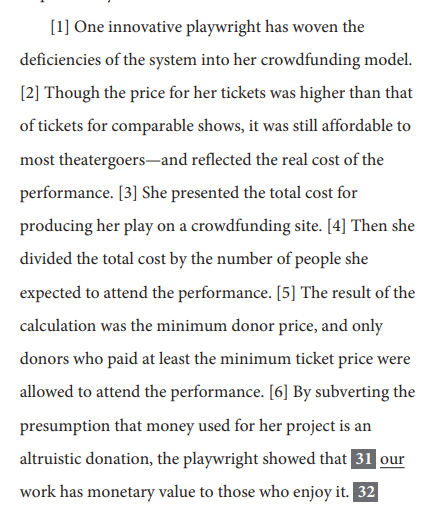
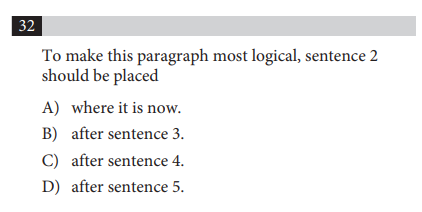
Question 5
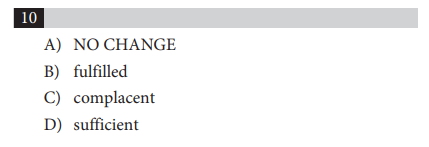
Question 6
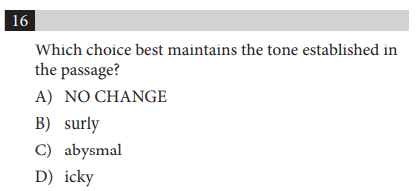
Question 7

Question 8

Question 9
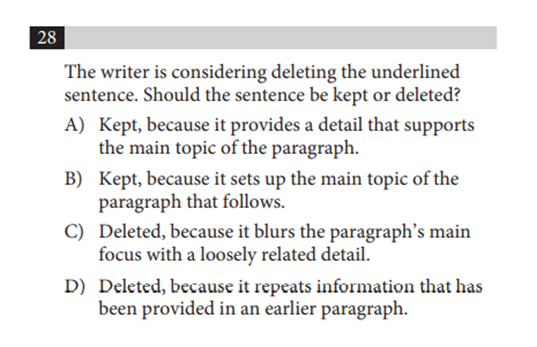
Question 10
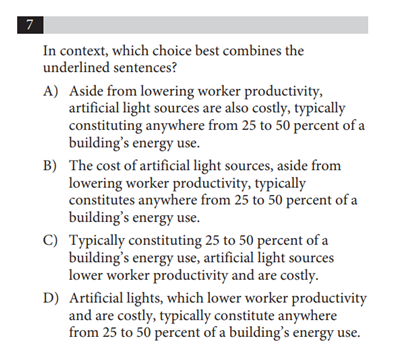
Question 11

Question 12
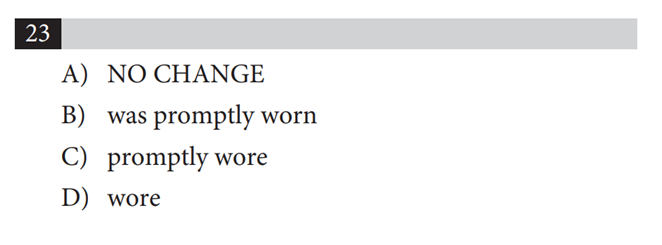
Question 13
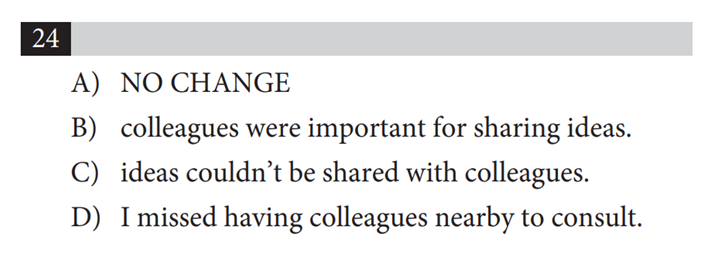
Question 14
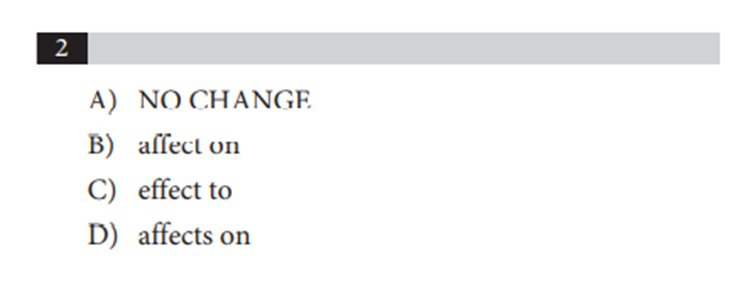
Question 15

Final Tips
